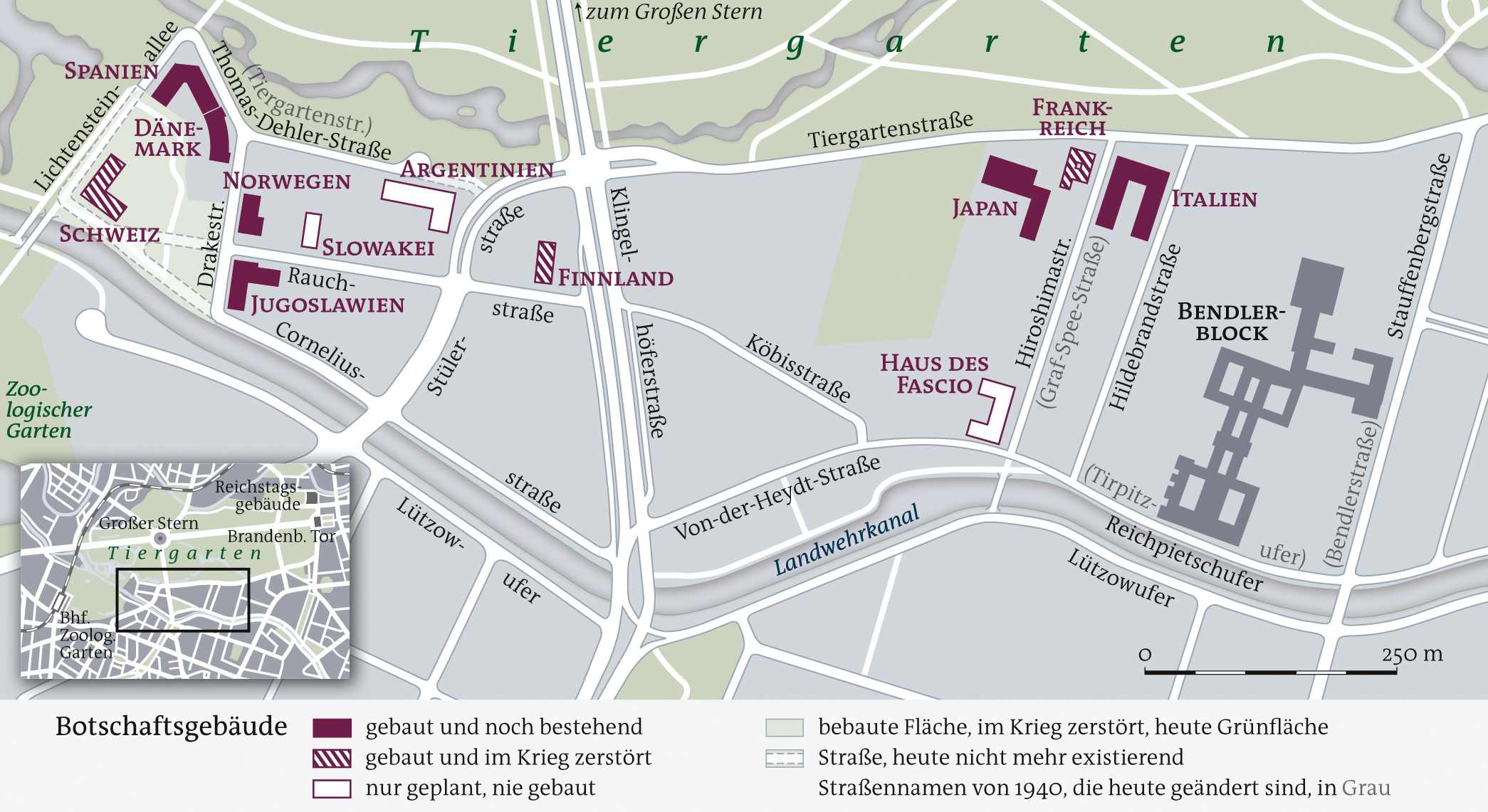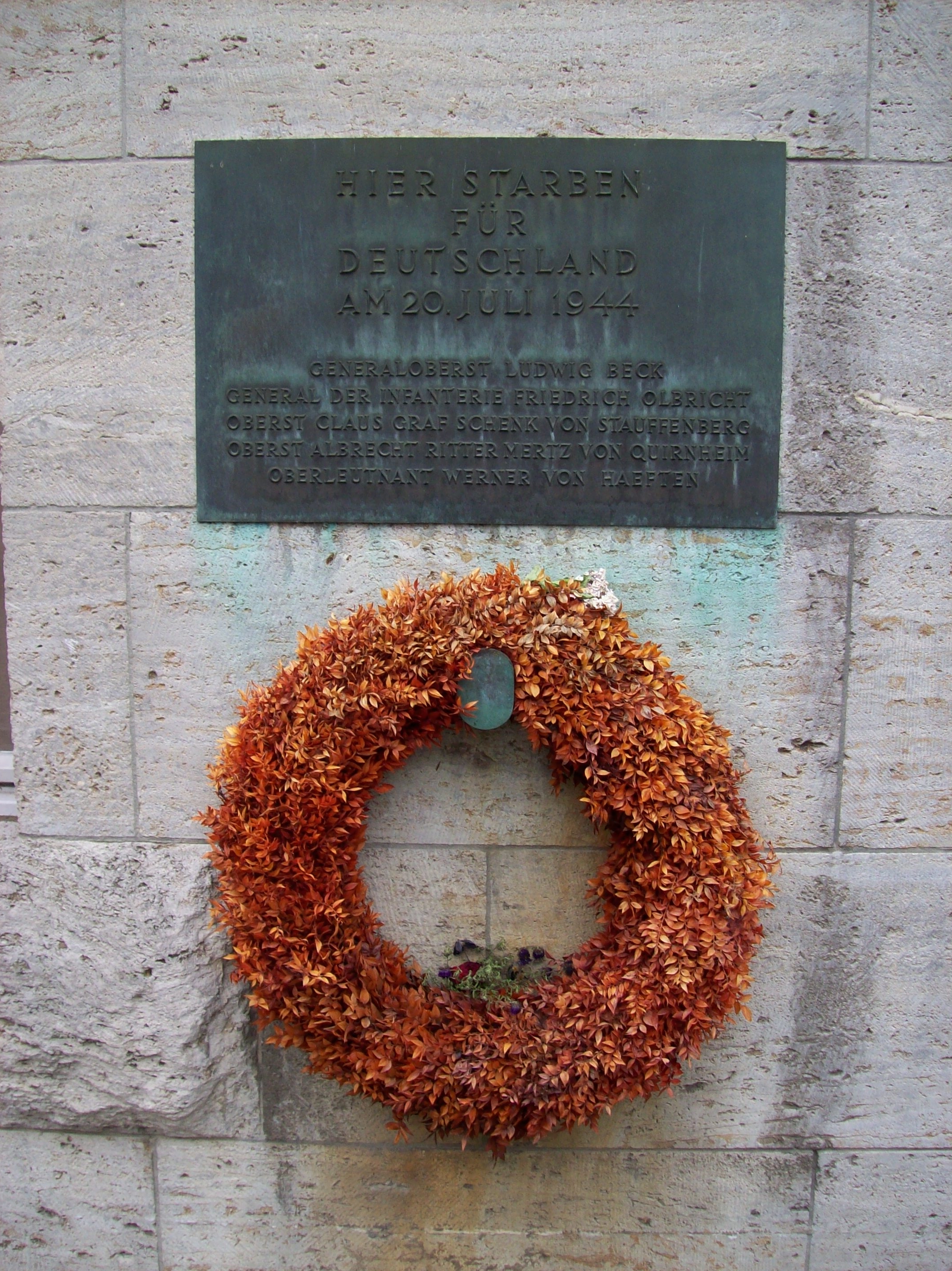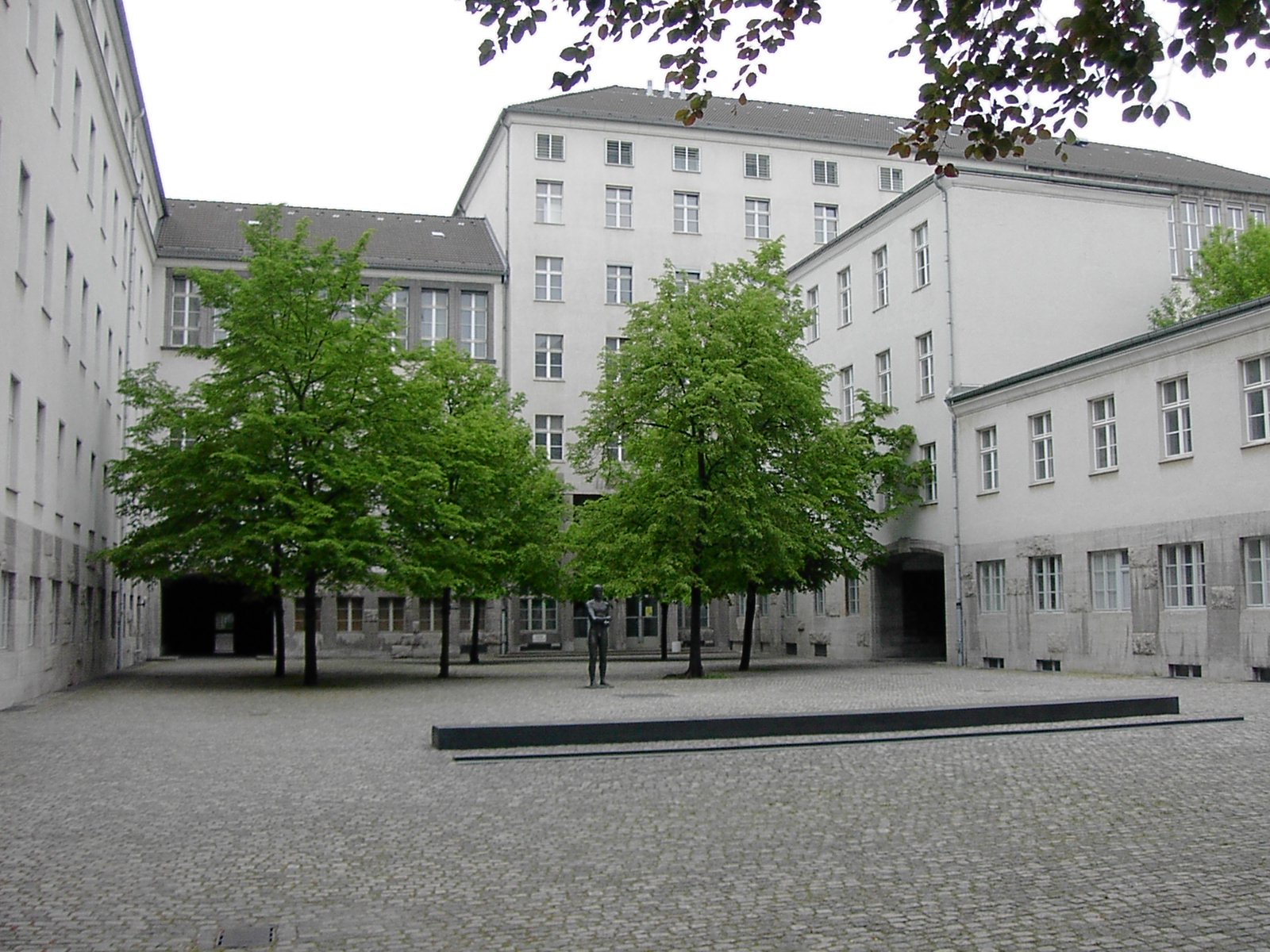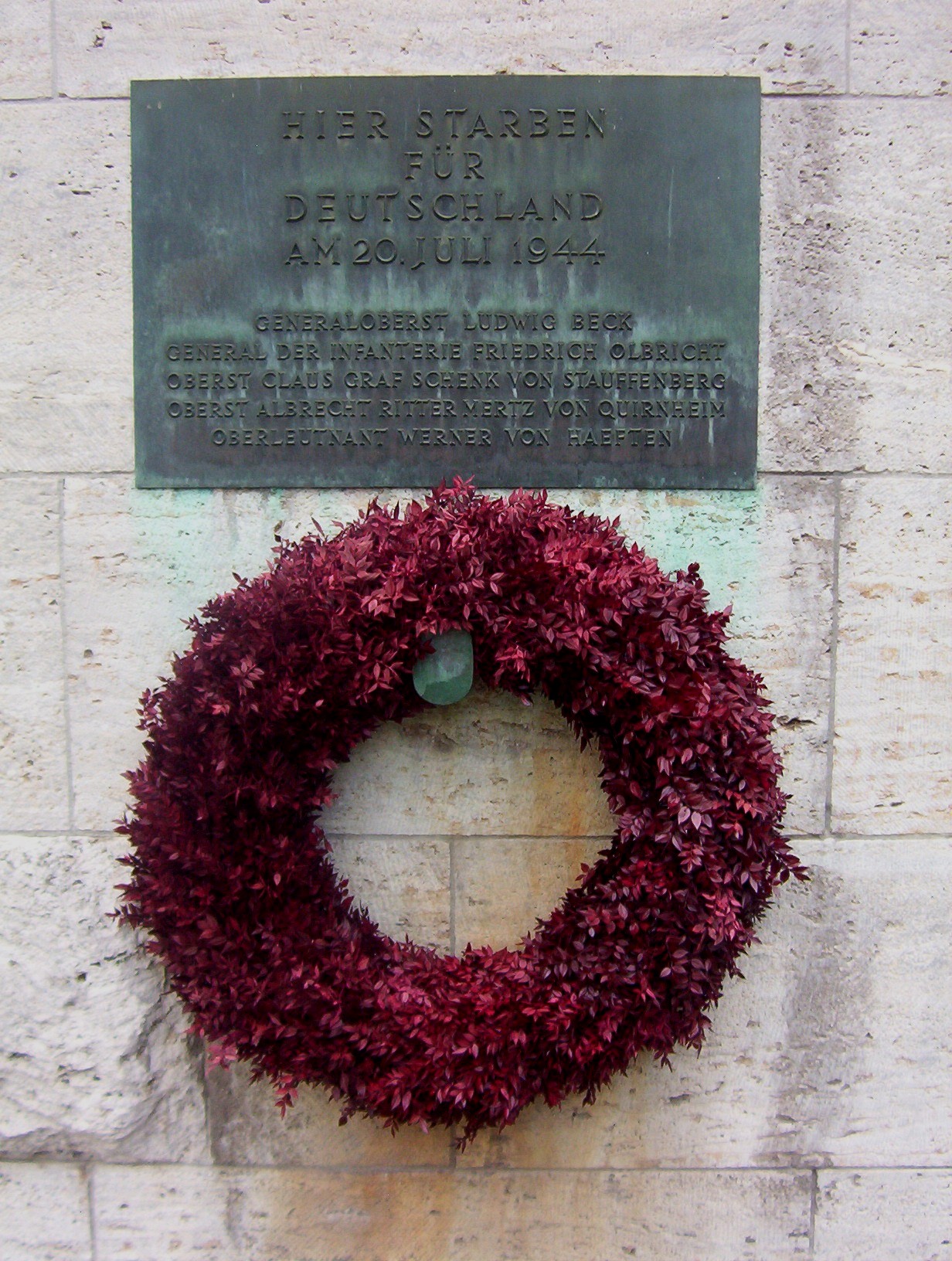|
Bendlerstrasse
The Bendlerblock () is a building complex in the Tiergarten district of Berlin, Germany, located on Stauffenbergstraße (formerly named ''Bendlerstraße''). Erected in 1914 as headquarters of several Imperial German Navy (''Kaiserliche Marine'') offices, it served the Ministry of the Reichswehr after World War I. Significantly enlarged under Nazi rule, it was used by several departments of the ''Oberkommando der Wehrmacht'' (OKW) from 1938, especially the ''Oberkommando des Heeres'' and the ''Abwehr'' intelligence agency. The building is notable as the headquarters of a resistance band of Wehrmacht officers who staged the 20 July plot against Adolf Hitler in 1944. As the leaders of the conspiracy were summarily shot in the courtyard, the Bendlerblock also includes the Memorial to the German Resistance. Since 1993, the building complex has served as a secondary seat of the German Federal Ministry of Defence. Name The complex got its name from the street it was on. Today, it ... [...More Info...] [...Related Items...] OR: [Wikipedia] [Google] [Baidu] |
Claus Von Stauffenberg
Claus Philipp Maria Justinian Schenk Graf von Stauffenberg (; 15 November 1907 – 21 July 1944) was a German army officer who is best known for his failed attempt on 20 July 1944 to assassinate Adolf Hitler at the Wolf's Lair, part of Operation Valkyrie, a plan that would have seen the arrest of Nazi leadership in the wake of Hitler's death and an earlier end to World War II. Stauffenberg took part in the Invasion of Poland, the 1941–42 invasion of the Soviet Union in Operation Barbarossa and the Tunisian campaign during the Second World War. Alongside Major Generals Henning von Tresckow and Hans Oster, he became a key figure in the German resistance to Nazism within the . On 20 July 1944, Stauffenberg's assassination attempt failed, the explosive he had placed only dealing Hitler minor injuries. The conspirators were arrested, and many of them executed, including Stauffenberg on the day after the attempt. His wife Nina was also arrested, giving birth to their fifth ... [...More Info...] [...Related Items...] OR: [Wikipedia] [Google] [Baidu] |
Memorial To The German Resistance
The German Resistance Memorial Center () is a memorial and museum in Berlin, capital of Germany. History It was opened in 1980 in part of the Bendlerblock, a complex of offices in Stauffenbergstrasse (formerly Bendlerstrasse), south of the Großer Tiergarten in Tiergarten. It was here that Colonel Claus Schenk Graf von Stauffenberg and other leaders of the 20 July plot, who had just attempted to assassinate Adolf Hitler as a decapitation strike and a prelude to regime change, were executed without trial after the plot failed. Although the memorial is primarily intended to commemorate those members of the German Army who tried to assassinate Hitler in 1944, it is also a memorial to the German resistance in the broader sense. Historians agree that there was no united, national resistance movement in Nazi Germany at any time during Hitler's years in power (1933–45). Joachim Fest describes it as "the resistance that never was." In the divided, ideologically different, and ... [...More Info...] [...Related Items...] OR: [Wikipedia] [Google] [Baidu] |
German Resistance To Nazism
The German resistance to Nazism () included unarmed and armed opposition and disobedience to the Nazi Germany, Nazi regime by various movements, groups and individuals by various means, from assassination attempts on Adolf Hitler, attempts to assassinate Adolf Hitler or to overthrow his regime, defection to the enemies of the Third Reich and sabotage against the German Army and the apparatus of repression and attempts to organize armed struggle, to open protests, rescue of persecuted persons, dissidence and "everyday resistance". German resistance was not recognized as a united resistance movement during the height of Nazi Germany, unlike the more organised efforts in other countries, such as Italian Resistance, Italy, Danish resistance movement, Denmark, the Soviet partisans, Soviet Union, Polish Underground State, Poland, Greek Resistance, Greece, Yugoslav Partisans, Yugoslavia, French Resistance, France, Dutch resistance, the Netherlands, Resistance in the Protectorate of Bo ... [...More Info...] [...Related Items...] OR: [Wikipedia] [Google] [Baidu] |
Hoym
Hoym () is a town and former municipality in the district of Salzlandkreis in the German state of Saxony-Anhalt. Since 15 July 2009, it is part of the town Seeland. Hoym is located on the river Selke, between the towns Aschersleben and Quedlinburg. One of the main features of the town is Schloss Hoym, which is used as a home for the mentally handicapped. Hoym is part of the ''Verwaltungsgemeinschaft'' ("collective municipality") Seeland, district Salzlandkreis Salzland is a district in the middle of Saxony-Anhalt, Germany. Its area is . It is bounded by (from the west and clockwise) the districts Harz, Börde, Magdeburg, Jerichower Land, Anhalt-Bitterfeld, Mansfeld-Südharz and Saalekreis. History .... Olympian Burckhardt Hoppe was born here. References Towns in Saxony-Anhalt Former municipalities in Saxony-Anhalt Seeland, Germany {{Salzlandkreis-geo-stub ... [...More Info...] [...Related Items...] OR: [Wikipedia] [Google] [Baidu] |
Principality Of Halberstadt
The Principality of Halberstadt () was a state of the Holy Roman Empire ruled by Brandenburg-Prussia. It replaced the Bishopric of Halberstadt after its secularization in 1648. Its capital was Halberstadt. In 1807, the principality was made a state or regional capital of the Kingdom of Westphalia. In 1813, control of the principality was restored, and its sovereign rights were confirmed as the possession of the Kingdom of Prussia. History According to the Peace of Westphalia of 1648, the former prince-bishopric was secularized as the Principality of Halberstadt and together with Magdeburg, Minden and Cammin given to the Brandenburg Elector Frederick William I of Hohenzollern as a compensation for Western Pomerania, which in the aftermath of the Brandenburg-Pomeranian conflict he had to cede to Sweden. This agreement was negotiated by Frederick William's representative Joachim Friedrich von Blumenthal, who in reward was appointed Halberstadt's first secular governor. The ... [...More Info...] [...Related Items...] OR: [Wikipedia] [Google] [Baidu] |
Bricklayer
A bricklayer, which is related to but different from a mason, is a craftsperson and tradesperson who lays bricks to construct brickwork. The terms also refer to personnel who use blocks to construct blockwork walls and other forms of masonry. In British and Australian English, a bricklayer is colloquially known as a "brickie". A stone mason is one who lays any combination of stones, cinder blocks, and bricks in construction of building walls and other works. Bricklaying is a part of masonry. Bricklaying may also be enjoyed as a hobby. For example, the former British Prime Minister Winston Churchill did bricklaying as a hobby. Bricklayers occasionally enter competitions where both speed and accuracy are judged. The largest is the "Spec-Mix Bricklayer 500" held annually in Las Vegas, Nevada, USA. Required training Professional bricklayers usually go through a formal apprenticeship which includes about three to four years of on-the-job training combined with classroom ins ... [...More Info...] [...Related Items...] OR: [Wikipedia] [Google] [Baidu] |
Großer Tiergarten
The Tiergarten (, ), formal German name: (, or deer park, game hunting park), is a prominent park in Berlin's inner-city area, located completely in the district of the same name. It is one of the most popular parks in the city and at in size, is among the largest urban gardens in Germany. Only the '' Tempelhofer Park'' (previously Berlin's Tempelhof airport) and Munich's '' Englischer Garten'' are larger. History 16th century The beginnings of the Tiergarten can be traced back to 1527. It was founded as a hunting area for the Elector of Brandenburg, and was situated to the west of the Cölln city wall, which was the sister town of Old Berlin. It also sat in the same vicinity as the City Palace (''Stadtschloss''). In 1530 the expansion began; acres of land were purchased and the garden began to expand towards the north and west. The total area extended beyond the current Tiergarten, and the forests were perfect for hunting deer and other wild animals (''Tiergarten'' ... [...More Info...] [...Related Items...] OR: [Wikipedia] [Google] [Baidu] |
Landwehr Canal
The Landwehr Canal (), is a canal parallel to the Spree river in Berlin, Germany, built between 1845 and 1850 to plans by Peter Joseph Lenné. It connects the upper part of the Spree at the eastern harbour () in Friedrichshain with its lower part in Charlottenburg, flowing through Kreuzberg and Tiergarten. History Lenné designed a canal with sloped walls, an average width of at the surface and locks near both ends to control the water depth. In the course of two enlargements (1883–1890 and 1936–1941), it reached a breadth of and a depth of . Today the waterway is mainly used by tourist boats and pleasure craft. About The Landwehr Canal leaves the Spree River in the eastern harbour in Friedrichshain, east of the city centre. It immediately descends through the upper lock () and heads in a straight line south west to its junction with the Neukölln Ship Canal, which provides a connection to the Teltow Canal. Here the Landwehr Canal turns north west through Kre ... [...More Info...] [...Related Items...] OR: [Wikipedia] [Google] [Baidu] |
Tiergartenstraße
Tiergartenstraße, or Tiergartenstrasse (see ß), is a street in the Tiergarten district in central Berlin, the capital of Germany. The street runs east-west along the southern edge of the Großer Tiergarten park from Kemperplatz and Ben-Gurion-Straße near Sony Center and Potsdamer Platz in the east to the intersection of Hofjägerallee and Klingelhöferstraße in the west. On the street’s southern side, the street intersects with (from east to west), Herbert-von-Karajan-Straße, Stauffenbergstraße, Hildebrandstraße, Hiroshimastraße and Clara-Wieck-Straße. The neighbourhood was incorporated into the City of Berlin in 1861, soon after the 1871 Unification of Germany it developed into an affluent residential area and later into the capital's diplomatic quarter. Notable sights The Kemperplatz at the eastern end formerly marked the starting point of the Siegesallee boulevard running northwards through the park to Königsplatz in front of the Reichstag. On Tiergart ... [...More Info...] [...Related Items...] OR: [Wikipedia] [Google] [Baidu] |
Neoclassicism
Neoclassicism, also spelled Neo-classicism, emerged as a Western cultural movement in the decorative arts, decorative and visual arts, literature, theatre, music, and architecture that drew inspiration from the art and culture of classical antiquity. Neoclassicism was born in Rome, largely due to the writings of Johann Joachim Winckelmann during the rediscovery of Pompeii and Herculaneum. Its popularity expanded throughout Europe as a generation of European art students finished their Grand Tour and returned from Italy to their home countries with newly rediscovered Greco-Roman ideals. The main Neoclassical movement coincided with the 18th-century Age of Enlightenment, and continued into the early 19th century, eventually competing with Romanticism. In architecture, the style endured throughout the 19th, 20th, and into the 21st century. European Neoclassicism in the visual arts began in opposition to the then-dominant Rococo style. Rococo architecture emphasizes grace, Ornament ... [...More Info...] [...Related Items...] OR: [Wikipedia] [Google] [Baidu] |
German Imperial Naval Office
The Imperial Naval Office () was a government agency of the German Empire. It was established in April 1889, when the German Imperial Admiralty was abolished and its duties divided among three new entities: the Imperial Naval High Command (''Kaiserliches Oberkommando der Marine''), the Imperial Naval Cabinet (''Kaiserliches Marinekabinett'') and the Imperial Naval Office performing the functions of a ministry for the Imperial German Navy. Structure and tasks According to the 1871 Constitution of the German Empire, the federal states were responsible for the German land forces and the imperial government for the navy. So while there were Prussian, Bavarian, Saxon and Württemberg armies, there was a single Imperial Navy, the only formation under the direct authority of the German Reich beside the colonial ''Schutztruppe'' forces. The head of the Naval Office was a Secretary of State who reported directly to the Imperial Chancellor (''Reichskanzler''). While the operational ... [...More Info...] [...Related Items...] OR: [Wikipedia] [Google] [Baidu] |





